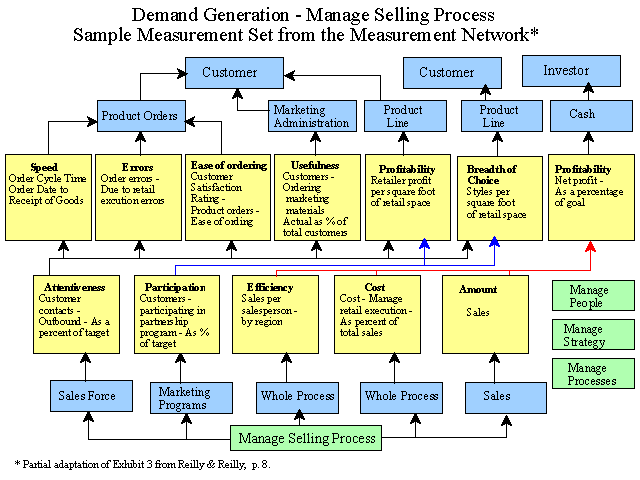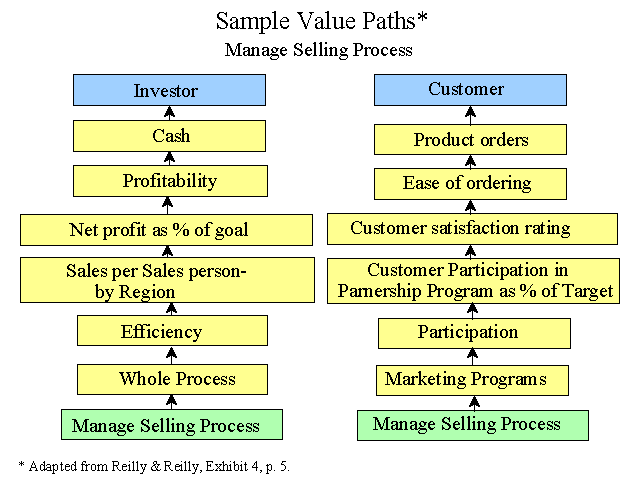
Summary by Anamaris Gonzalez
Master of Accountancy Program
University of South Florida, Fall 2004
Balanced Scorecard Main Page | Performance Measures Main Page
A business performance measurement system monitors activities within a company that create value for stakeholders. The use of a measurement system helps in determining whether performance is satisfactory or not. Measures offer an opportunity to better understand the current performance and provide insight into what needs improvement. A measurement system also makes it easier to evaluate employee performance.
Roles and Limitations of Measurements
There are certain limitations associated with measurement systems. At times the information provided does not coincide with the information needed by managers. Also, it is not possible to measure something that will create value in the future.
Sometimes the selected components for measuring performance do not directly affect the outcome in question. The authors discuss a measure that involves the sales per number of employees. They say that expression of output may be more accurate if profit is used and warn us that the number of employees is not the only factor that creates the output. Managers may misinterpret this measure and try to improve things with actions that will eventually be detrimental to the company. The real challenge when creating measures is to be able to combine the business idea with management decisions that will help in creating even more value for stakeholders.
Another issue that proves difficult is interrelating all of the individual measures. It is not always obvious how changes in one measure will affect another measure. The authors say that accounting measures can be easily related but since they are based on historical cost they do not coffer a complete view of the organization.
Measurement System Principles
In order to create a measurement system managers may start with a brainstorming session related to the measurements and measurement characteristics that they would like to have in place.
The authors developed a list of characteristics that managers would like to see in a measurement system based on hundreds of interviews and related surveys results.
The system should ensure that value is created for the stakeholders and help managers in their decision making by giving insight into future outcomes.
Measurements should be systematic.
Measurements should help the company accomplishment a strategy by tracking its activities.
A measure should be logical and express what stakeholders want delivered.
The number of measurements within the organization should be limited by including only those that are most important.
Measurement standards should take into consideration what is going on in the rest of the industry. Managers should make use of benchmarks if available.
A measurement system should inspire users to understand the system and create a culture that understands the power of the information that measurements provide. Results should be openly communicated and the system should be easy for everyone to use.
The Balanced Scorecard
The authors discuss and criticize the balance scorecard approach. The BSC looks at measurements from different perspectives (customer, financial, business, and learning), and makes use of financial as well as nonfinancial measures. The current business position is revealed through different measures for each specific unit within the organization as well as the organization in its entirety. The balance scorecard focuses more on accomplishing the business strategy.
Although the balanced scorecard serves some of the purposes of a performance measurement system, it has some limitations. First, the balanced scorecard does not define appropriate balance, particularly in terms of stakeholder value. In addition, a balanced scorecard designed around a company's strategy is not necessarily complete, and the linkages among measurements and between perspectives is not explicit. The use of a measurement network is suggested instead.
The Measure Network
The measure network consists of the structure of stakeholder value that describes what each stakeholder expects from the company, the structure of primary and support business activities that facilitate value creation, and the management processes needed to achieve this.
A measure network makes sure to evaluate how a business is measuring up in terms of creating value for stakeholders. Value creation does not happen over night. Stakeholders are looking for the organization that will offer them more. Managers may at times sacrifice current profits for higher future profits.
In a measure network there are a series of benefits and costs exchanged between the stakeholder and the firm, referred to as deliverables. Deliverables are considered as part of the objectives of the firm from a stakeholders' point of view, but deliverables that they get from the stakeholders' aid in the process of achieving the objectives. The stakeholders' deliverable attributes shape the deliverables and help managers identify that which would give them a competitive edge. Therefore, management should develop performance measurements based on these attribute-deliverable relationships, create comparisons, and then keep only the key measurements.
The authors divide all business activities into three types of processes:
Primary Business Processes,
Support Business Processes, and
Management Processes.
All of these processes are inter-linked and recognizing them would benefit the value creation for stakeholders. Recognizing and managing those processes helps managers in planning and controlling the activities. To measure processes managers make use of elements related to them such as an input or an output, an employee or perhaps the process itself. Identifying all of the elements in a process is important in developing measures for them. Also, by defining process attributes it is easier to identify those processes that are critical for value creation.
Certain difficulties may arise from the use of a measurement system. Sometimes measurements may provide too much or not enough information making it hard to find a balance. Also, it may be difficult to have the measurements meet all of management’s needs. Finally the relationship between an employee and the objectives of the firm may not always be obvious.
Measurement Sets and Value Paths in the Measure Network
The measure network includes two tools: measure sets and value paths. To reduce the difficulties that may arise, a measure set should be created. When creating a measure set only the measures that managers need are selected from the network. It should combine measures that facilitate activity control and measures that will help in understanding the relationship between the activities at an organizational unit and the firm in general. Developing a measure set includes identifying the process in the organizational unit, then the stakeholder deliverable attributes that are directly affected by the process that will provide the greatest contribution to the firm. Finally, appropriate measures are classified by importance. The most important measures are tested for completeness and a selection is made for the measure set. A sample measure set "Manage Selling Process" appears below.

Another important tool used is the value path. The value path links a process to a deliverable through performance measures. The value path is derived from the measure set. The measure set and value path help reduce the number of measures, connect the units of the organization to deliverables and help focus the attention on performance. The following graphic illustrates two sample value paths for the measure set "Manage Selling Process."

The authors believe that the measure network fulfills the requirements of an ideal measurement system. It represents the relationships between the firm’s business and the goal of the stakeholders. Its transparency should help in creating a positive measurement culture, motivation to continually reevaluate the effectiveness of the measurements, and mold the measurement system to managers' needs. The use of a measure network will help managers in making sure that value is created for stakeholders.
______________________________________________
Related summaries:
Estes, R. 1992. Social accounting past and future: Should the profession lead, follow - or just get out of the way? Advances In Management Accounting (1): 97-108. (Note and Summary).
Handy, C. 2002. What's a business for? Harvard Business Review (December): 49-55. (Summary).
Ittner, C. D. and D. F. Larcker. 2003. Coming up short on nonfinancial performance measurement. Harvard Business Review (November): 88-95. (Summary).
Kaplan, R. and D. Norton. 1992.The balanced scorecard - Measures that drive performance. Harvard Business Review (Jan-Feb): 71-79. (Summary).
Kaplan, R. S. and D. P. Norton. 1996. The Balanced Scorecard: Translating Strategy into Action Boston: Harvard Business School Press. (Summary).
Kaplan, R. S. and D. P. Norton. 2001. The Strategy-Focused Organization: How Balanced Scorecard Companies Thrive in the New Business Environment. Harvard Business School Press. (Summary).
Lipe, M. and S. Salterio. 2000. The balanced scorecard: Judgmental effects of common and unique performance measures. The Accounting Review (July): 283-298. (Summary).
Lipe, M. G. and S. Salterio. 2002. A note on the judgmental effects of the balanced scorecard's information organization. Accounting, Organizations and Society 27(6): 531-540. (Summary).
Norreklit, H. 2003. The balanced scorecard: What is the score? A rhetorical analysis of the balanced scorecard. Accounting, Organizations and Society 28(6): 591-619. (Summary).
Ridgway, V. F. 1956. Dysfunctional consequences of performance measurements. Administrative Science Quarterly (September): 240-247. (Summary).
Schonberger, R. J. 2008. Lean performance management (Metrics don't add up). Cost Management (January/February): 5-10. (Note: Schonberger criticizes the KPI or scorecard approach from the lean enterprise perspective. Summary).
Tatikonda, L. U. and R. J. Tatikonda. 1998. We need dynamic performance measures. Management Accounting (September): 49-53. (Summary).